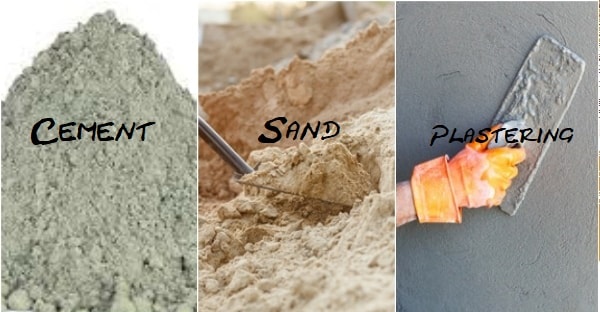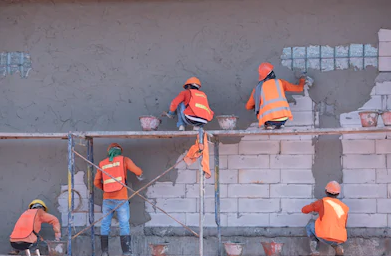Finishing coat on the exterior and interior walls are very important and it must have the Maximum Thickness of Cement Plaster to offer the required body of material to harden precisely under site conditions in any building construction.
Plastering the walls is important and it must be coated properly to achieve the minimum thickness level and it is also important to offer the ultimate finishing to the wall surface and to add durability to the walls.
From concealing the even surfaces to making the walls look clean and smoother, plastering of walls is extremely important for any construction project.
To have a satisfying base for distempering, painting, color or whitewashing it is necessary that walls are coated perfectly with cement first. The mortar or plastic materials that are used in the process are usually mixed with different building materials like gypsum, lime, cement, water, and sand.
If you are looking for construction companies in hyderabad then check this list and get your construction work done with expert.
What is the recommended thickness of cement plaster?
The thickness of cement plaster usually depends on the surface on which it is to be applied and its composition. The Cement for House Construction usually has the following thickness levels.
- The minimum thickness of cement plaster must be of 10mm and it is sufficient to maintain satisfying smoothness on the surface of concrete walls.
- Brick masonry surfaces that are uneven must have a plaster thickness of 12mm and it may extend up to 18mm.
- Any surface that is uneven demands for a higher thickness of plaster but it must not exceed 20mm in thickness.
The two coatings of cement plaster must have a total thickness level of 20mm and it must not exceed this thickness level. If three coating of cement plaster is applied, then ensure to keep the thickness level up to 25mm only.
Check these latest main gate pillar design that will make your house entrance a grand enterance.
The thickness of 20mm is usually used for exterior walls, while for interior walls, 15mm thickness is sufficient. For ceilings, the thickness of plaster must be of 10mm which is sufficient and offers a smoother surface of the paintwork.

Best cement and sand ratio for wall plastering
Contractors use varied proportions of sand and cement to achieve the required homogenous plaster mixture. Below are some crucial aspects which are considered when finding the Ideal Cement and Sand Ratio for Wall Plastering!
- Environmental conditions that affect the ceiling and walls.
- Grade and type of cement.
- Grading and type of sand.
- The location where the plaster is to be coated, whether it is exterior walls or the interior walls.
The proportion mixture for finishing coat on walls usually depends on the colour of wall surface required and its texture. After finding the right proportion of sand and cement mixture the ingredients are properly mixed in a cement mortar mixer. Firstly the dry mortar is mixed and then water is added so as to achieve the required consistency.
Cement and Mortar Mixer
In order to prepare plaster mixture, the portable water is used and the water must be free from organic impurities and chlorides like the alkalis, oils, silt, salt and acids. These impurities will weaken the mixture.
The water quantity must be equivalent to 28% by weight of the cement and 4% by weight of all aggregates and this ratio is important to enhance the strength and durability of the plaster. The materials must be saturated, surface dry and non-absorbent so that the mixture would work efficiently and give the foundation maximum strength.
Have a look at unique boundary wall design here while gettings a boundary wall constructed
The quantity of water used for plasterwork with the proportion ratio of 1:3 is 70% of the weight of cement and the water quantity may vary depending upon varied factors mentioned below.
- Nature and condition of fine aggregate.
- The richness of the mixture whether it is rich or leaner than the ratio of 1:3.
- Humidity and temperature at the time of plastering.
- Admixtures included for enhancing the workability.
- Different quantities of lime in composite mortars.
For all regular plasterwork, the water quantity is taken as 20% of total cement weight and aggregates. But to achieve the best results, it is necessary that the quantity of water is worked out based on the cement content mix and the thickness of plasterwork.
Once it is ready, you can apply it manually or you may use the plastering machine for achieving the best results and finishing.
Looking for house front wall cement design for your home? Keep visiting DecorChamp.com for latest designs.
Manual plastering is suggested only for small areas, while the automatic plastering machines are best when it comes to plastering larger areas of offices and homes, especially the exterior walls of a house.



I can’t thank you enough for sharing this information with us. The thickness of cement plaster depends on the manual application and the thickness of the base. This is the key takeaway for me. Looking forward to more of your posts.
I can’t thank you enough for sharing this information with us. The thickness of cement plaster depends on the manual application and the thickness of the base. This is the key takeaway for me. Looking forward to more of your posts.
Really appreciate this informative article